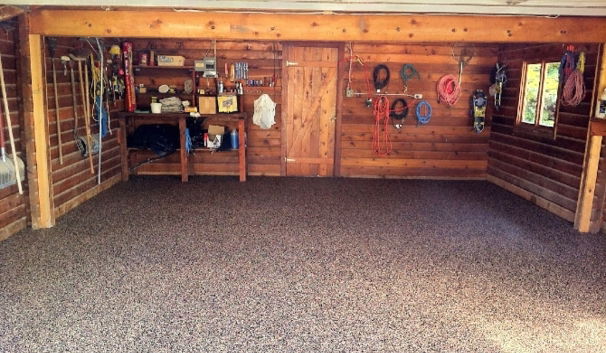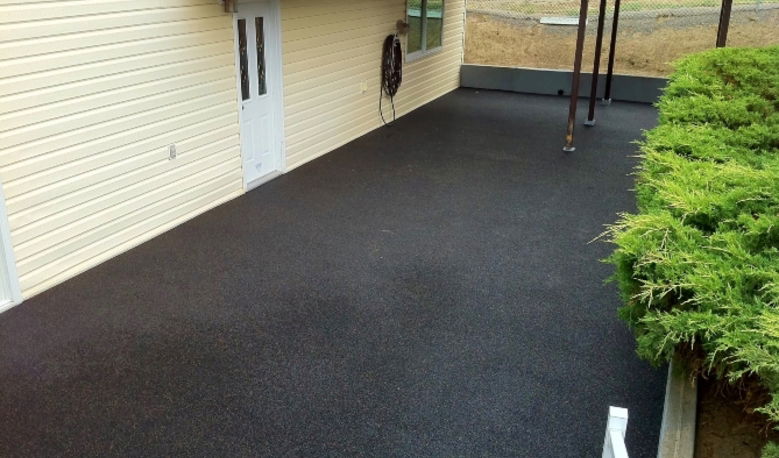
Call Now: (250) 828-2182
Which is better for resurfacing? Concrete or Rubber?
Pour-in-place rubber resurfacing is a technique that involves applying a recycled rubber and epoxy mixture onto an existing concrete, tile, or asphalt surface. This creates a tough and seamless layer that is both slip-resistant and resistant to various weather conditions. It is commonly used for playgrounds, pool decks, driveways, and walkways.
In contrast, concrete resurfacing is a process where a thin layer of fresh concrete is applied to an existing concrete surface. This method improves both the durability and appearance of the surface without the need for a complete replacement.
Cost Comparison
Up-front Cost: Rubber resurfacing tends to be pricier initially because the materials involved are more expensive. On the other hand, concrete resurfacing generally has lower upfront costs since it relies on commonly available traditional concrete materials.
Long-Term Expenses: When it comes to long-term costs, rubber resurfacing has some advantages over concrete resurfacing.
Rubber surfaces are known for being durable and needing less maintenance, which means fewer repairs, replacements, and regular upkeep. They resist cracking, chipping, and fading, which can save money over time. Plus, maintaining rubber surfaces often involves simple tasks like occasional cleaning, sealing, or reapplying, which are usually affordable.
On the other hand, concrete surfaces may require more maintenance and repairs over their lifetime, leading to higher long-term costs. While concrete resurfacing may have lower upfront expenses, the durability and low maintenance needs of rubber resurfacing can make it a more cost-effective option in the long run.
Durability and Lifespan Comparison
Rubber resurfacing is well-known in the surfacing industry for its incredible durability. It can resist cracks, chips, and impacts, making it tough against heavy foot traffic and harsh weather. While the lifespan of rubber resurfacing can vary, it is generally considered to last longer than concrete and asphalt, often surpassing 15 years.
In comparison, concrete resurfacing is also durable, but it can be more prone to cracking and chipping over time, especially in places with extreme freeze-thaw cycles like Canada. Although the lifespan of concrete resurfacing can be extended through proper maintenance and the use of sealants, the thin layer of concrete will eventually lose its structural integrity.
Considering the overall durability and lifespan, rubber resurfacing has an advantage over concrete resurfacing. It can withstand impacts and adapt to different weather conditions, making it a reliable choice.
Rubber Stone Maintenance: Taking care of rubber resurfacing is a breeze with its minimal maintenance needs. It naturally resists stains, so all you need is occasional cleaning using a pressure washer, mild soap, and water to remove dirt and debris. To keep it looking great and strong, resealing or applying a topcoat every 4-5 years is necessary.
Concrete Maintenance: On the other hand, concrete resurfacing requires more maintenance and ongoing repairs. Since concrete is porous, it easily stains and needs regular cleaning and sealing to protect against moisture and stains. Depending on the conditions and how it's used, concrete resurfacing may need frequent sealing, repairs for cracks or chips, and periodic reapplication of protective coatings.
Overall, rubber resurfacing has lower maintenance requirements compared to concrete resurfacing, making it a hassle-free choice for keeping surfaces in great condition over the long term.
Customization
Unleash your creativity with an array of customization possibilities offered by rubber resurfacing and concrete resurfacing. Here's how each option stands out:
Rubber Resurfacing
Colors Galore: Dive into a wide spectrum of 1, 2, and 3-color mixes that let you personalize your surface according to your taste.
Patterns, Shapes, and Logos: Get imaginative by adding unique patterns, logos, or designs, transforming your surface into a personalized masterpiece.
Take a look at our photo gallery for inspiration
Concrete Resurfacing
Artistic Finishes: Elevate your concrete surface with decorative finishes like stamps, stencils, or exposed aggregates, making it visually appealing and one-of-a-kind.
Colorful Stains: Using an array of stained or dyed colors you can create a surface that truly reflects your style. (requires regular sealing)
Borders that Wow: Unleash your creativity by crafting intricate borders or replicating the look of natural stone, tile, or concrete using various stamps.
In conclusion, rubber resurfacing offers more color options and pattern choices. Concrete resurfacing offers customization through artistic finishes, colorful stains, and the ability to replicate patterns. Which option will you choose?
Environmental Impact
When evaluating the environmental impact of rubber resurfacing versus concrete resurfacing, several factors come into play:
Rubber Resurfacing
Eco-Friendly Materials: Rubber resurfacing materials are made from recycled tires, helping to reduce the amount of waste in landfills.
Environmental Impact: By reusing rubber materials, the need for new production is minimized, resulting in a smaller environmental footprint compared to concrete resurfacing.
Water Management: When properly sealed, rubber surfaces are typically non-porous, which can assist in managing stormwater by reducing water runoff.
Concrete Resurfacing
Resource Depletion: Concrete resurfacing requires new concrete materials, which involves extracting natural resources like aggregates and cement.
High Energy Consumption: The production of concrete involves energy-intensive processes such as quarrying, transportation, and cement production, contributing to higher carbon emissions.
Waste Generation: Demolishing existing concrete surfaces during resurfacing can generate significant waste, potentially leading to more waste ending up in landfills.
In conclusion, rubber resurfacing stands out for its use of recycled materials, reducing landfill waste and having a lower carbon footprint. Additionally, properly sealed rubber surfaces aid in water management. On the other hand, concrete resurfacing relies on new concrete materials, which deplete natural resources, has higher energy consumption during production, and generates waste during the process.
HOURS
Mon to Sat
Sat &Sun
8AM - 5PM
Closed


